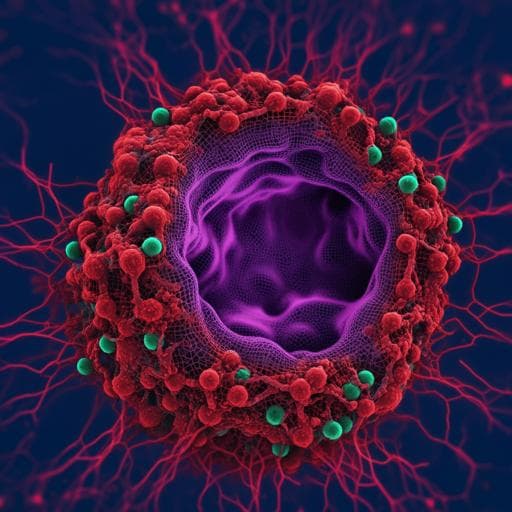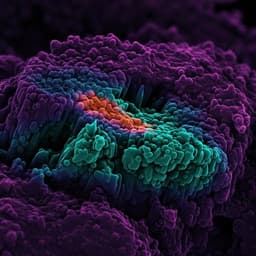
Chemistry
Optimal acceleration voltage for near-atomic resolution imaging of layer-stacked 2D polymer thin films
B. Liang, Y. Zhang, et al.
This groundbreaking study by Baokun Liang et al. demonstrates that adjusting the incident electron energy can significantly enhance the resolution of high-resolution transmission electron microscopy (HRTEM) images. With an impressive resolution of 1.9 Å at 120 kV, the research uncovers unexpected molecular interstitial defects in two imine-based 2D polymer thin films and sheds light on functional groups at pore interfaces in amorphous organic materials.
~3 min • Beginner • English
Introduction
Organic 2D crystals such as 2D polymers and layer-stacked covalent organic frameworks (COFs) have broad application potential (e.g., OFETs, solar cells, filtration, catalysis), where structural elucidation at near-atomic scale is key to linking structure and function. A particularly important feature is the designability of pore interfaces and tunable porosity via functional side groups. However, precise characterization of pore interfaces and the structure of amorphous organic 2D materials remains challenging. Although aberration-corrected HRTEM can reach sub-Å resolution, organic specimens suffer severe electron irradiation damage, limiting achievable resolution and masking local features (defects, boundaries, side groups). For amorphous organic 2D materials, weak scattering and lack of Bragg peaks reduce S/N, and high-fluence strategies used for inorganic amorphous materials are not viable due to damage. Prior approaches to mitigate damage include low-dose imaging, direct electron detectors, vitrification, and encapsulation. The prevalent assumption has favored high acceleration voltages (e.g., 300 kV) to reduce radiolysis; however, for thin organic 2D crystals, the balance between elastic and inelastic scattering changes with energy, suggesting that lower voltages may increase the fraction of information-carrying electrons. This work asks: what is the optimal acceleration voltage to maximize high-resolution structural information from 2D polymer thin films under dose-limited conditions?
Literature Review
The authors review that in organic materials radiolysis dominates damage, historically favoring high voltages due to σ_i ∝ 1/β², while σ_e ∝ 1/β² as well, and σ_e/σ_i decreases with increasing energy. Russo and co-workers showed ~25% improvement in σ_e/σ_i at ~100 kV over 300 kV, implying more structural information per unit damage in thin specimens. Conventional strategies for beam-sensitive materials include low-dose techniques, use of direct detectors for higher S/N at low fluence, and methods that restrain damage propagation (vitrification, encapsulation). For amorphous inorganic 2D materials, sufficient contrast can be achieved by higher fluence, which is not applicable to organic analogs. Chromatic aberration at low voltages can blur images due to inelastic electrons being defocused, though chromatic correction can mitigate this. Prior TEM on organic 2D crystals was mostly at 300 kV; exploration of lower voltages for such materials has been scarce.
Methodology
Materials: Two imine-based 2D polyimine thin films (2D-PI-BPDA and 2D-PI-DhTPA) synthesized by SMAIS using TAPP nodes with BPDA or DhTPA linkers; thickness up to 60 nm. An amorphous polyimine film (a-PI) related to a viologen-immobilized 2D polymer was also prepared.
Microscopy: TEM performed on an image-side aberration-corrected FEI Titan 80-300 at 80, 120, and 300 kV, and a Thermo Fisher Talos at 200 kV. The Titan had a CEOS hexapole corrector (3rd-order axial aberrations). Data were acquired on a Gatan UltraScan CCD (Titan) and a Ceta CMOS (Talos).
Low-dose workflow for AC-HRTEM: Imaging comprised search, focus, and acquisition with a pre-specimen shutter to blank the beam. Search at 0.2 e−/Ų·s flux and large pixel size (41.62 Å) with objective aperture to enhance contrast. For acquisition: pixel size 0.836 Å (information to 1.67 Å), flux 420 e−/Ų·s, beam diameter 230 nm. Focus adjusted at an adjacent area, typical defocus ~30 nm; final single-image acquisition with total fluence ~76 e−/Ų (0.18 s). Multislice HRTEM simulations performed in QSTEM.
SAED and critical fluence: At 80, 120, 200, and 300 kV, SAED series were recorded at constant flux (0.48 e−/Ų·s) at five positions per energy. The fading of integrated reflection intensities versus accumulated fluence was analyzed to determine the critical fluence ε_c for specified resolution ranges (e.g., 5–6 nm⁻¹). Machine learning: a U-Net was trained to detect Bragg spots automatically and generate integrated intensity profiles; intensities across all reflections in a resolution band were integrated to improve robustness. The critical fluence was defined when intensity dropped to 1/e of initial.
Efficiency of electron usage: On low-dose SAED (total ~2 e−/Ų), the proportion of elastically scattered electrons ε_el was quantified as I_Bragg / I_total (including the central beam). Neural-network-assisted analysis was used to segment and integrate I_Bragg and I_total.
Information coefficient: To balance dose tolerance and structural information fraction, an information coefficient ζ combining ε_el with dose tolerance was defined to assess overall efficiency of an acceleration voltage for reaching high resolution.
Image simulations and contrast maps: Thickness–defocus contrast maps at 120 and 300 kV were simulated for the two target polymers and three additional 2D polymers. Contrast was quantified via the coefficient of variation of image grayscale; relative contrast gains (Contrast_120 − Contrast_300)/Contrast_300 were mapped.
Structure modeling: Atomic models for crystalline polymers were obtained by SCC-DFTB (ADF-DFTB 2019, 3ob-3-1 parameters, D3(BJ) dispersion). Interstitial TAPP defect configurations were explored (aligned A-type shifts and rotated R-type), and multi-layer statistical models (e.g., 120 layers with randomized interstitial distributions) were generated for image simulations.
Amorphous a-PI analysis: AC-HRTEM at 120 kV resolved local network. A three-network U-Net pipeline located node positions, polygon centers, and masked unusable regions. Delaunay triangulation and subsequent processing yielded bond lengths/angles, nearest-neighbor distributions, polygon mapping, and statistics across multiple fields of view.
Key Findings
- Optimal acceleration voltage: 120 kV maximizes the information coefficient ζ across 80–300 kV for both 2D-PI-BPDA and 2D-PI-DhTPA, balancing higher ε_el and acceptable dose tolerance.
- Achieved image resolution: HRTEM images at 120 kV reached 1.9 Å (FFT reflections up to ~5 nm⁻¹ and beyond) with total fluences near the critical dose for 1.7–2.0 Å (≈80 e−/Ų).
- Dose tolerance and scattering behavior: Critical fluence ε_c decreases with decreasing acceleration voltage (more radiolysis). The fraction of elastically scattered electrons ε_el increases as voltage decreases, peaking around 120 kV and dropping at 80 kV due to dynamical and inelastic scattering effects in finite thickness samples.
- Contrast improvement: Simulations predict a 41–113% contrast increase at 120 kV vs 300 kV for thicknesses below 10 nm. Experimentally, enhanced contrast at 120 kV enabled imaging at low defocus (≈40–50 nm), reducing contrast delocalization and allowing clear visualization of ~4 Å porphyrin pores.
- Discovery of interstitial defects: Previously unreported molecular interstitial TAPP defects were identified. In 2D-PI-BPDA, R-type (rotated ~42°) interstitials reproduce characteristic four-spot contrast near porphyrin nodes. In 2D-PI-DhTPA, A-type slip interstitials (rotation ~31°, slip along symmetry axes) yield crescent contrasts. DFTB energetics are consistent with the observed preferences (R-type in BPDA, A-type in DhTPA).
- Functional group detection at pore interfaces: Linker widths differ measurably between BPDA and DhTPA; real-space averaging and line profiles show FWHMs of ~2.3 Å (BPDA) vs ~2.9 Å (DhTPA), consistent with the presence of hydroxyl groups in DhTPA.
- Amorphous 2D polymer imaging: At 120 kV, short-range order in an amorphous polyimine thin film was resolved. Neural-network analysis mapped a mixture of hexagons with defects (pentagons and heptagons), quantified polygon distributions across nine images (200 nm² FOV each), and extracted bond length/angle statistics.
- Thickness dependence and chromatic effects: The empirical optimum at 120 kV (thickness up to 60 nm) aligns with biological-specimen findings; for thinner specimens the optimum likely shifts lower. At lower voltages, increased inelastic scattering and chromatic aberration can reduce phase contrast and blur images unless corrected.
Discussion
Selecting 120 kV as the operating voltage maximizes the number of information-carrying electrons within the dose budget for organic 2D polymer thin films, directly addressing the challenge of dose-limited resolution. This energy optimizes the trade-off between elastic scattering (which conveys structural information) and inelastic/damage processes, improving S/N and enabling lower defocus operation that minimizes delocalization. As a result, near-atomic details such as porphyrin pores and linker-side-group effects become discernible, which were previously inaccessible at conventional 300 kV under comparable dose constraints. The enhanced imaging at 120 kV also reveals subtle structural deviations, notably interstitial TAPP defects with distinct stacking motifs in different polymers, linking local chemistry and stacking energetics to observable contrast features. Extending the same conditions to amorphous films provides sufficient contrast to quantify short-range order using machine learning, demonstrating broader applicability to weakly scattering organic 2D materials. Overall, the findings show that carefully optimizing acceleration voltage can bridge the gap between instrument-limited and damage-limited resolution in organic 2D materials and unlock new insights into defects and pore-interface chemistry.
Conclusion
The study establishes 120 kV as the optimal acceleration voltage, among 80–300 kV, for near-atomic-resolution AC-HRTEM of layer-stacked 2D polyimine thin films, achieving 1.9 Å resolution with enhanced image contrast and reduced delocalization. This enabled one-to-one mapping of framework structures, distinction of linker functionalization, and discovery of previously unreported interstitial TAPP defects with polymer-dependent stacking motifs. The optimized conditions also facilitated quantitative analysis of short-range order in an amorphous organic 2D polymer via neural networks. Future research should investigate how optimal energy shifts with decreasing specimen thickness, evaluate the benefits of chromatic aberration correction to refocus coherent inelastic electrons and further boost contrast, and develop robust routes to prepare and functionalize thin, highly ordered organic 2D films to extend direct visualization of more complex pore-interface chemistries.
Limitations
- Dependence on specimen thickness: The optimal energy (120 kV here for films up to ~60 nm) is thickness-dependent; thinner samples may benefit from even lower voltages, while thicker ones may behave differently.
- Inelastic scattering and chromatic aberration: At lower voltages, increased inelastic events reduce elastic amplitudes and, coupled with chromatic aberration, can blur images unless chromatic correction is available.
- Material scope: Findings are demonstrated on two imine-based 2D polymers and one amorphous polyimine; generalization to other organic 2D materials requires further validation.
- Sample preparation challenges: Maintaining long-range order in few- to few-tens-of-nanometer-thick organic films and implementing controlled pore-interface functionalization remain nontrivial and may limit broader applicability.
- Machine learning training data: Some neural-network analyses used limited training sets for SAED spot detection; while effective here, broader generalization may require larger, more diverse datasets.
Related Publications
Explore these studies to deepen your understanding of the subject.







